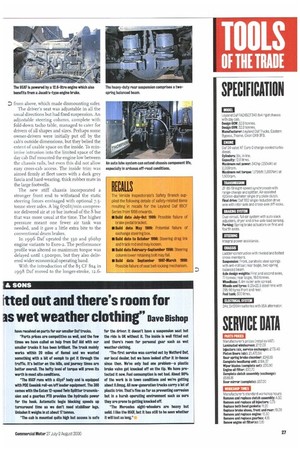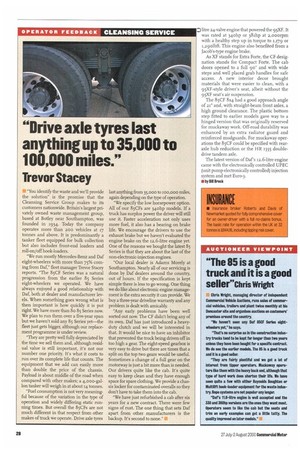The Daf 85 Series is tough as old boots, productive
Page 26

Page 29

Page 30

If you've noticed an error in this article please click here to report it so we can fix it.
and offers tippermen a spacious, comfortable cab. No wonder used examples are snapped up fast.
afs,85 Series was launched in May T993, hard on the heels of the Leyland Daf 8x4 Constructor 30-tonner. Des own maximumweight FAD 2700 rigid ceased production at the end of 199o. The 85 8x4 chassis was designed to operate at the new 32-tonne limit, but for the UK market the engineers at Thame reduced the unladen weight to give a good payload on top of the durable driveline.
With a Daf cab, Daf chassis, Daf axles and Daf engine it bore little resemblance to the Leyland model that had served the construction industry so well for more than a decade.
Daf's 95 Series had become the first vehicle 2 to use the ii.6-litre engine five years earlier. Uprated in 1991 for the 85, this engine met the Euro-I emission standard from the outset and came with a proven record. It was good 2' on fuel and was said to be good for a million kilometres. In tipper mode three options, g rated at 3oohp, 33ohp and 36ohp, gave a go choice of outputs to suit a wide range of operations. At its most popular 33ohp option, a
useful 9961bft of torque was available at just r,morpm, which was ideal for arduous off
road, low-speed lugging.
Drive was transmitted via a 42omm-diameter single-plate clutch to an eight-speed synchromesh ZF range-change gearbox for 300 and 33ohp models, which Daf still considers sufficient at 32 tonnes. The standard box for the 36ohp model was the constantmesh 12-speed Eaton TwinSplitter.
The cab design was pretty innovative. It was slightly tapered front to rear with flared wings covering the front wheels at the full 2.5m width. A bonded front screen blended with rounded corners to give a smooth front profile; even the drip channels on the roof were omitted to ensure a clean air flow and cut out wind noise. Flush door handles, mounted low down and facing rearwards, were designed to stay relatively clean.
Unusually, the large door windows contained a smaller wind-down section. This provided good visibility and made the interior of the cab light without the risk of too much ventilation. Two wide, tiered steps could be seen from above, which made dismounting safer.
The driver's seat was adjustable in all the usual directions but had fixed suspension. An adjustable steering column, complete with fold-down tacho table, managed to cater for drivers of all shapes and sizes. Perhaps some owner-drivers were initially put off by the cab's outside dimensions, but they belied the extent of usable space on the inside. To minimise intrusion into the limited space of the day cab Daf mounted the engine low between the chassis rails, but even this did not allow easy cross-cab access. The inside trim was aimed firmly at fleet users with a dark grey fascia and hard-wearing, thick rubber mats in the large footwells.
The new stiff chassis incorporated a stronger front end to withstand the static steering forces envisaged with optional 7.5tonne steer axles. A big 67olit/min compressor delivered air at co bar instead of the 8 bar that was more usual at the time. The higher pressure meant one fewer air tank was needed, and it gave a little extra bite to the conventional drum brakes.
In 1996 Daf uprated the 33o and 360hp engine variants to Euro-2. The performance profile was altered so maximum torque was delayed until 1,500rpm, but they also delivered wider economical operating band.
With the introduction of the 85 CF 8x4 in 1998 Daf moved to the longer-stroke, 12.6 Dare 24-valve engine that powered the 95XF. It was rated at 340hp or 381hp at 2,0 oorpm with a healthy step up in torque to 1,179 or 1,29olbft. This engine also benefited from a Jacob's-type engine brake.
As XF stands for Extra Forte, the CF designation stands for Compact Forte. The cab doors opened to a full 900 and with wide steps and well placed grab handles for safe access. A new interior decor brought materials that were easier to clean, with a 95XF-style driver's seat, albeit without the 95XF seat's air suspension.
The 85CF 8x4 had a good approach angle of 21° and, with straight-beam front axles, a high ground dearance. The plastic bottom step fitted to earlier models gave way to a hinged version that was originally reserved for muckaway work. Off-road durability was enhanced by an extra radiator guard and reinforced mudguards. For muckaway operations the 85CF could be specified with rearaxle hub reduction or the HR 1355 doubledrive tandem axle.
The latest version of Oaf's i2.6-litre engine came with the electronically controlled UPEC (unit pump electronically controlled) injection system and met Euro-3.
• by Bill Brock












































































































